Yi Liu
PaddleOCR-VL: Boosting Multilingual Document Parsing via a 0.9B Ultra-Compact Vision-Language Model
Oct 16, 2025Abstract:In this report, we propose PaddleOCR-VL, a SOTA and resource-efficient model tailored for document parsing. Its core component is PaddleOCR-VL-0.9B, a compact yet powerful vision-language model (VLM) that integrates a NaViT-style dynamic resolution visual encoder with the ERNIE-4.5-0.3B language model to enable accurate element recognition. This innovative model efficiently supports 109 languages and excels in recognizing complex elements (e.g., text, tables, formulas, and charts), while maintaining minimal resource consumption. Through comprehensive evaluations on widely used public benchmarks and in-house benchmarks, PaddleOCR-VL achieves SOTA performance in both page-level document parsing and element-level recognition. It significantly outperforms existing solutions, exhibits strong competitiveness against top-tier VLMs, and delivers fast inference speeds. These strengths make it highly suitable for practical deployment in real-world scenarios.
PubSub-VFL: Towards Efficient Two-Party Split Learning in Heterogeneous Environments via Publisher/Subscriber Architecture
Oct 14, 2025Abstract:With the rapid advancement of the digital economy, data collaboration between organizations has become a well-established business model, driving the growth of various industries. However, privacy concerns make direct data sharing impractical. To address this, Two-Party Split Learning (a.k.a. Vertical Federated Learning (VFL)) has emerged as a promising solution for secure collaborative learning. Despite its advantages, this architecture still suffers from low computational resource utilization and training efficiency. Specifically, its synchronous dependency design increases training latency, while resource and data heterogeneity among participants further hinder efficient computation. To overcome these challenges, we propose PubSub-VFL, a novel VFL paradigm with a Publisher/Subscriber architecture optimized for two-party collaborative learning with high computational efficiency. PubSub-VFL leverages the decoupling capabilities of the Pub/Sub architecture and the data parallelism of the parameter server architecture to design a hierarchical asynchronous mechanism, reducing training latency and improving system efficiency. Additionally, to mitigate the training imbalance caused by resource and data heterogeneity, we formalize an optimization problem based on participants' system profiles, enabling the selection of optimal hyperparameters while preserving privacy. We conduct a theoretical analysis to demonstrate that PubSub-VFL achieves stable convergence and is compatible with security protocols such as differential privacy. Extensive case studies on five benchmark datasets further validate its effectiveness, showing that, compared to state-of-the-art baselines, PubSub-VFL not only accelerates training by $2 \sim 7\times$ without compromising accuracy, but also achieves a computational resource utilization rate of up to 91.07%.
Sample Efficient Experience Replay in Non-stationary Environments
Sep 18, 2025Abstract:Reinforcement learning (RL) in non-stationary environments is challenging, as changing dynamics and rewards quickly make past experiences outdated. Traditional experience replay (ER) methods, especially those using TD-error prioritization, struggle to distinguish between changes caused by the agent's policy and those from the environment, resulting in inefficient learning under dynamic conditions. To address this challenge, we propose the Discrepancy of Environment Dynamics (DoE), a metric that isolates the effects of environment shifts on value functions. Building on this, we introduce Discrepancy of Environment Prioritized Experience Replay (DEER), an adaptive ER framework that prioritizes transitions based on both policy updates and environmental changes. DEER uses a binary classifier to detect environment changes and applies distinct prioritization strategies before and after each shift, enabling more sample-efficient learning. Experiments on four non-stationary benchmarks demonstrate that DEER further improves the performance of off-policy algorithms by 11.54 percent compared to the best-performing state-of-the-art ER methods.
Rate doubly robust estimation for weighted average treatment effects
Sep 18, 2025Abstract:The weighted average treatment effect (WATE) defines a versatile class of causal estimands for populations characterized by propensity score weights, including the average treatment effect (ATE), treatment effect on the treated (ATT), on controls (ATC), and for the overlap population (ATO). WATE has broad applicability in social and medical research, as many datasets from these fields align with its framework. However, the literature lacks a systematic investigation into the robustness and efficiency conditions for WATE estimation. Although doubly robust (DR) estimators are well-studied for ATE, their applicability to other WATEs remains uncertain. This paper investigates whether widely used WATEs admit DR or rate doubly robust (RDR) estimators and assesses the role of nuisance function accuracy, particularly with machine learning. Using semiparametric efficient influence function (EIF) theory and double/debiased machine learning (DML), we propose three RDR estimators under specific rate and regularity conditions and evaluate their performance via Monte Carlo simulations. Applications to NHANES data on smoking and blood lead levels, and SIPP data on 401(k) eligibility, demonstrate the methods' practical relevance in medical and social sciences.
Avoiding Knowledge Edit Skipping in Multi-hop Question Answering with Guided Decomposition
Sep 09, 2025Abstract:In a rapidly evolving world where information updates swiftly, knowledge in large language models (LLMs) becomes outdated quickly. Retraining LLMs is not a cost-effective option, making knowledge editing (KE) without modifying parameters particularly necessary. We find that although existing retrieval-augmented generation (RAG)-based KE methods excel at editing simple knowledge, they struggle with KE in multi-hop question answering due to the issue of "edit skipping", which refers to skipping the relevant edited fact in inference. In addition to the diversity of natural language expressions of knowledge, edit skipping also arises from the mismatch between the granularity of LLMs in problem-solving and the facts in the edited memory. To address this issue, we propose a novel Iterative Retrieval-Augmented Knowledge Editing method with guided decomposition (IRAKE) through the guidance from single edited facts and entire edited cases. Experimental results demonstrate that IRAKE mitigates the failure of editing caused by edit skipping and outperforms state-of-the-art methods for KE in multi-hop question answering.
Answering the Unanswerable Is to Err Knowingly: Analyzing and Mitigating Abstention Failures in Large Reasoning Models
Aug 26, 2025Abstract:Large reasoning models (LRMs) have shown remarkable progress on complex reasoning tasks. However, some questions posed to LRMs are inherently unanswerable, such as math problems lacking sufficient conditions. We find that LRMs continually fail to provide appropriate abstentions when confronted with these unanswerable questions. In this paper, we systematically analyze, investigate, and resolve this issue for trustworthy AI. We first conduct a detailed analysis of the distinct response behaviors of LRMs when facing unanswerable questions. Then, we show that LRMs possess sufficient cognitive capabilities to recognize the flaws in these questions. However, they fail to exhibit appropriate abstention behavior, revealing a misalignment between their internal cognition and external response. Finally, to resolve this issue, we propose a lightweight, two-stage method that combines cognitive monitoring with inference-time intervention. Experimental results demonstrate that our method significantly improves the abstention rate while maintaining the overall reasoning performance.
Beyond Tokens: Enhancing RTL Quality Estimation via Structural Graph Learning
Aug 26, 2025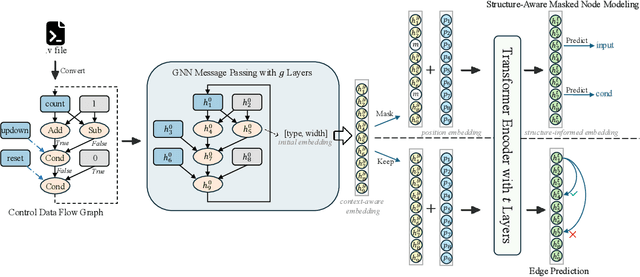
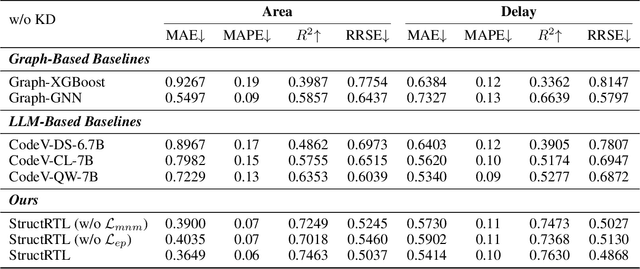
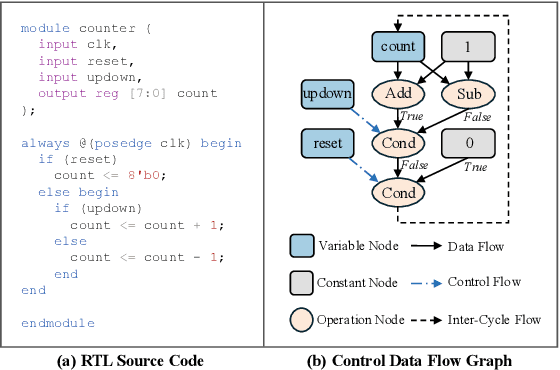
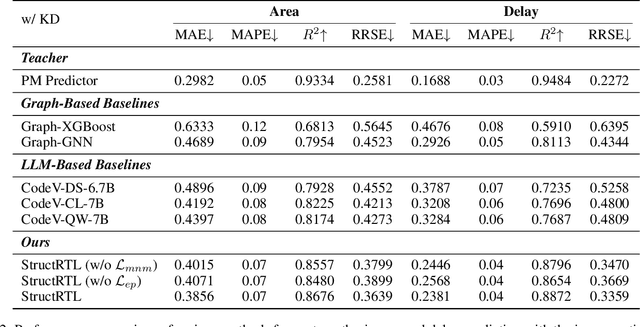
Abstract:Estimating the quality of register transfer level (RTL) designs is crucial in the electronic design automation (EDA) workflow, as it enables instant feedback on key metrics like area and delay without the need for time-consuming logic synthesis. While recent approaches have leveraged large language models (LLMs) to derive embeddings from RTL code and achieved promising results, they overlook the structural semantics essential for accurate quality estimation. In contrast, the control data flow graph (CDFG) view exposes the design's structural characteristics more explicitly, offering richer cues for representation learning. In this work, we introduce a novel structure-aware graph self-supervised learning framework, StructRTL, for improved RTL design quality estimation. By learning structure-informed representations from CDFGs, our method significantly outperforms prior art on various quality estimation tasks. To further boost performance, we incorporate a knowledge distillation strategy that transfers low-level insights from post-mapping netlists into the CDFG predictor. Experiments show that our approach establishes new state-of-the-art results, demonstrating the effectiveness of combining structural learning with cross-stage supervision.
Beyond Single: A Data Selection Principle for LLM Alignment via Fine-Grained Preference Signals
Aug 11, 2025Abstract:Aligning Large Language Models (LLMs) with diverse human values requires moving beyond a single holistic "better-than" preference criterion. While collecting fine-grained, aspect-specific preference data is more reliable and scalable, existing methods like Direct Preference Optimization (DPO) struggle with the severe noise and conflicts inherent in such aggregated datasets. In this paper, we tackle this challenge from a data-centric perspective. We first derive the Direct Multi-Preference Optimization (DMPO) objective, and uncover a key Preference Divergence (PD) term that quantifies inter-aspect preference conflicts. Instead of using this term for direct optimization, we leverage it to formulate a novel, theoretically-grounded data selection principle. Our principle advocates for selecting a subset of high-consensus data-identified by the most negative PD values-for efficient DPO training. We prove the optimality of this strategy by analyzing the loss bounds of the DMPO objective in the selection problem. To operationalize our approach, we introduce practical methods of PD term estimation and length bias mitigation, thereby proposing our PD selection method. Evaluation on the UltraFeedback dataset with three varying conflict levels shows that our simple yet effective strategy achieves over 10% relative improvement against both the standard holistic preference and a stronger oracle using aggregated preference signals, all while boosting training efficiency and obviating the need for intractable holistic preference annotating, unlocking the potential of robust LLM alignment via fine-grained preference signals.
P-Aligner: Enabling Pre-Alignment of Language Models via Principled Instruction Synthesis
Aug 06, 2025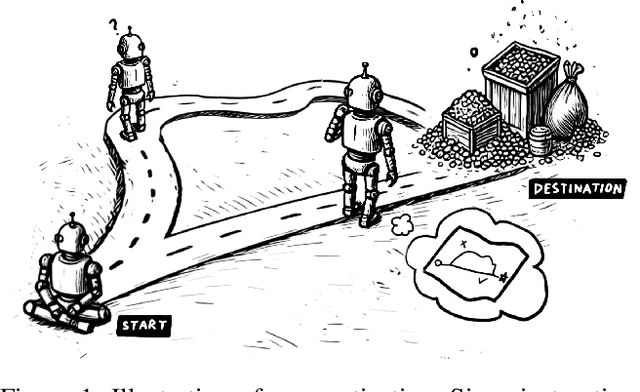
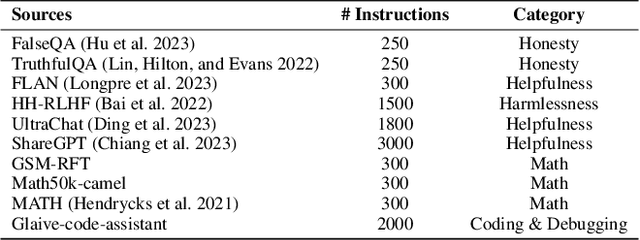
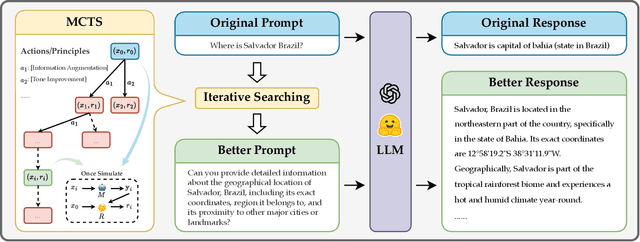
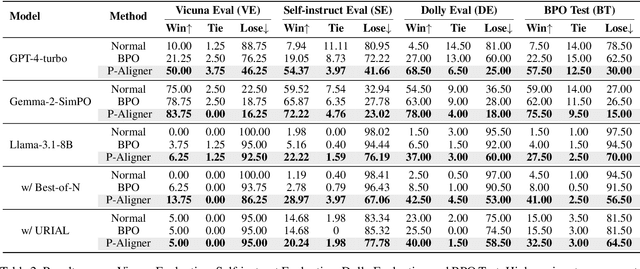
Abstract:Large Language Models (LLMs) are expected to produce safe, helpful, and honest content during interaction with human users, but they frequently fail to align with such values when given flawed instructions, e.g., missing context, ambiguous directives, or inappropriate tone, leaving substantial room for improvement along multiple dimensions. A cost-effective yet high-impact way is to pre-align instructions before the model begins decoding. Existing approaches either rely on prohibitive test-time search costs or end-to-end model rewrite, which is powered by a customized training corpus with unclear objectives. In this work, we demonstrate that the goal of efficient and effective preference alignment can be achieved by P-Aligner, a lightweight module generating instructions that preserve the original intents while being expressed in a more human-preferred form. P-Aligner is trained on UltraPrompt, a new dataset synthesized via a proposed principle-guided pipeline using Monte-Carlo Tree Search, which systematically explores the space of candidate instructions that are closely tied to human preference. Experiments across different methods show that P-Aligner generally outperforms strong baselines across various models and benchmarks, including average win-rate gains of 28.35% and 8.69% on GPT-4-turbo and Gemma-2-SimPO, respectively. Further analyses validate its effectiveness and efficiency through multiple perspectives, including data quality, search strategies, iterative deployment, and time overhead.
CoST: Efficient Collaborative Perception From Unified Spatiotemporal Perspective
Aug 01, 2025Abstract:Collaborative perception shares information among different agents and helps solving problems that individual agents may face, e.g., occlusions and small sensing range. Prior methods usually separate the multi-agent fusion and multi-time fusion into two consecutive steps. In contrast, this paper proposes an efficient collaborative perception that aggregates the observations from different agents (space) and different times into a unified spatio-temporal space simultanesouly. The unified spatio-temporal space brings two benefits, i.e., efficient feature transmission and superior feature fusion. 1) Efficient feature transmission: each static object yields a single observation in the spatial temporal space, and thus only requires transmission only once (whereas prior methods re-transmit all the object features multiple times). 2) superior feature fusion: merging the multi-agent and multi-time fusion into a unified spatial-temporal aggregation enables a more holistic perspective, thereby enhancing perception performance in challenging scenarios. Consequently, our Collaborative perception with Spatio-temporal Transformer (CoST) gains improvement in both efficiency and accuracy. Notably, CoST is not tied to any specific method and is compatible with a majority of previous methods, enhancing their accuracy while reducing the transmission bandwidth.
 Add to Chrome
Add to Chrome Add to Firefox
Add to Firefox Add to Edge
Add to Edge